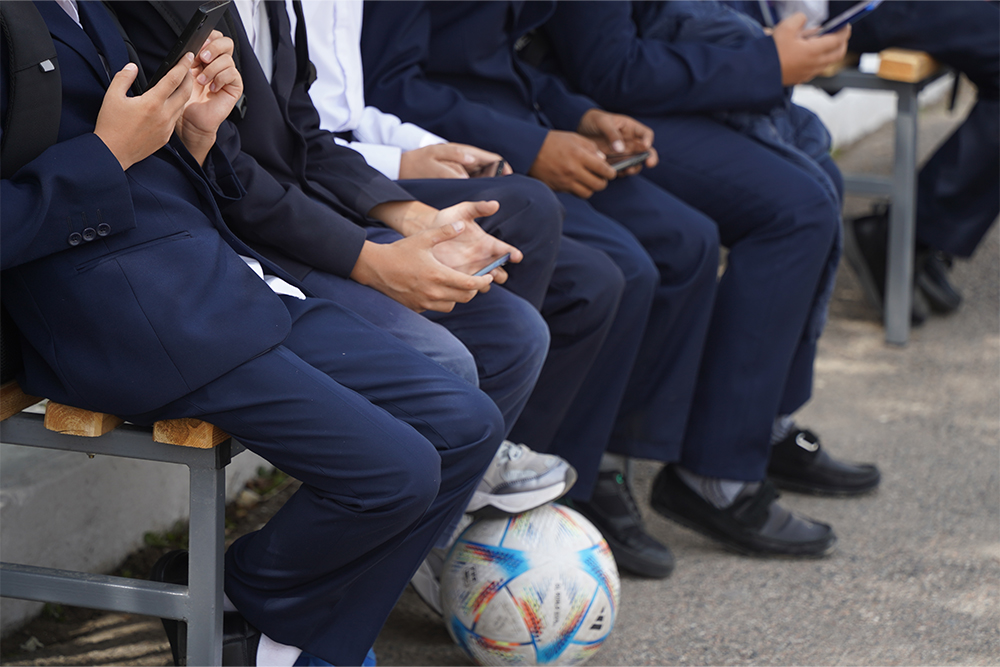
Many students bring mobile phones to school. Some use them for social media or messaging between lessons, while others use them to look up information, take notes or stay in contact with parents.
This raises a clear question: Are phones helping or causing harm?
Some schools ban them outright. Others allow limited use. For school staff and parents, this creates uncertainty.
In this blog, we explore the pros and cons of phones in schools, plus what the official guidance says.
Key Takeaways
- Mobile phones can support learning. Access to educational apps, quick fact-checking and multimedia content can all help students.
- Mobile phones can help with safety and peace of mind. Giving a child a mobile phone means they’re always reachable and can call parents or carers in an emergency.
- Schools that allow limited use of phones teach students digital responsibility.
- Phones are a major source of distraction in classrooms. Studies show that academic results improve in schools that ban them.
- Unrestricted phone access can lead to cyberbullying, peer pressure and privacy violations.
- The Department for Education (DfE) advises schools to ban the use of phones throughout the school day, including breaks.
Advantages of Mobile Phones in Schools
About 91% of children aged between 12 and 15 own a smartphone. When used correctly, these devices can support digital literacy and modern teaching.
1. Provides Learning Support
Phones can be used to look up facts, access educational apps and collaborate with classmates. Some schools use QR codes for lesson resources or let students record homework instructions.
2. Improves Safety and Communication
Phones help parents and children stay in contact during the day. They also allow students to call for help in emergencies, whether that’s walking home alone or reporting a serious concern.
For most caregivers, communication is the primary reason they allow their children to have phones. Knowing they’re always reachable is worth the potential downsides.
3. Teaches Digital Responsibility
Schools that allow limited phone use under supervision often take the opportunity to discuss safe online behaviour, such as avoiding scams and protecting their privacy. In theory, children also learn how to manage screen time and balance scrolling on their phones with other activities.
Disadvantages of Mobile Phones in Schools
1. Distraction in Lessons
Phones can easily become a distraction. Notifications, social media, games or messaging during class affect concentration.
In fact, a study by the London School of Economics suggests banning phones improves educational outcomes. Several schools reported better academic results after banning mobile phones. This was mostly seen in low-achieving students.
2. Cyberbullying and Peer Pressure
Phones open the door to cyberbullying, inappropriate content and unhealthy comparisons to peers. Malicious messages and photo-sharing can spread quickly and do real damage.
A recent survey of UK children between the ages of 10 and 15 found that one in five (19.1%) experienced cyberbullying in the past year.

3. Breaches of Privacy
Students may record videos or take photos of others without consent. These images can later be used for bullying.
For staff, being filmed during lessons without consent is equally concerning. Teachers have reported their lessons being shared online, often edited or mocked.
What Are UK Schools Doing?
The Department for Education recommends that all schools ban the use of mobile phones during the school day, including break times.
The DfE suggests:
- Collecting phones at the start of the day
- Securing them in lockers or bags
How Should Schools Handle It?
There’s no one-size-fits-all answer. But mobile phone policies should be:
- Clear – Everyone understands the rules
- Consistent – Staff enforce the rules the same way
- Communicated – Parents and pupils are informed
- Reviewed – Policies adapt based on changing risks
Schools must also teach pupils the risks of phone use, such as online predators, sexting or access to harmful content.
Advice for School Staff
If you’re a headteacher or safeguarding lead:
- Include mobile phones in your behaviour and safeguarding policies
- Set clear boundaries for phone use during school trips, clubs and unstructured time
- Train staff to recognise signs of cyberbullying and digital misuse
- Engage parents to support your approach at home
If you’re a parent or carer:
- Understand your child’s phone habits, including who they talk to and what apps they use
- Set limits on screen time, particularly around bedtimes
- Talk openly about online safety
- Respect the school’s policy on mobile phone use
Addressing Mobile Phone Risks Requires More Than Rules
Even with clear rules, children will probably still misuse phones.
School staff should be aware of the risks and warning signs of cyberbullying and inappropriate phone use. They also need to understand how to handle incidents and protect students.
That’s why schools need clear steps and proper training.
Why Safeguarding Training Matters
Inappropriate mobile phone use can quickly become a safeguarding concern. It may involve bullying, harassment, or exposure to harmful content – all of which require a clear, confident response from staff.
Safeguarding training ensures school staff know:
- How to recognise signs of abuse or harm
- What to do when pupils disclose online or offline risks
- Who to report concerns to
- How to support pupils while meeting legal and policy obligations
Safeguarding training will help you protect pupils from both online and offline harm.






















